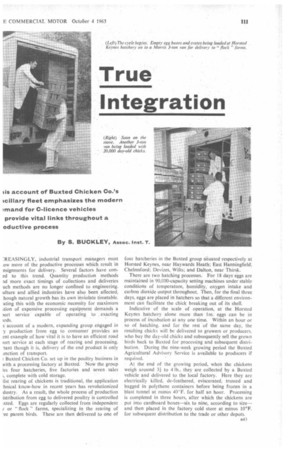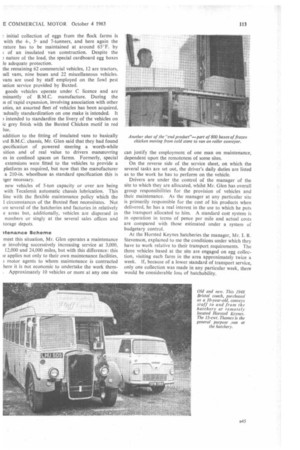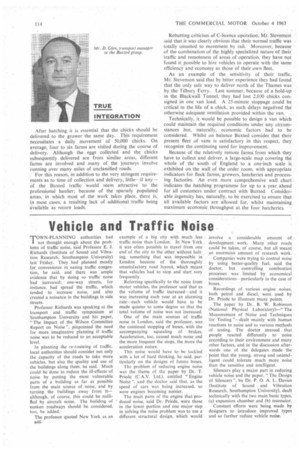True Integration
Page 113

Page 114

Page 115

Page 116

If you've noticed an error in this article please click here to report it so we can fix it.
us account of Buxted Chicken Co.'s icillary fleet emphasizes the modern flrtand for 0-licence vehicles provide vital links throughout a oductive process By S. BUCKLEY, Assoc. Inst. T.
:REASINGLY, industrial transport managers must ow more of the productive processes which result in nsignments for delivery. Several factors have coned to this trend. Quantity production methods 3d more exact timings of collections and deliveries uch methods are no longer confined to engineering. ulture and allied industries have also been affected, tough natural growth has its own inviolate timetable. 'Aug this with the economic necessity for maximum Ltion of expensive processing equipment demands a port service capable of operating to exacting trds.
s account of a modern, expanding group engaged in y production from egg to consumer provides an ent example of how vital it is to have an efficient road port service at each stage of rearing and processing. -tartt though it is, delivery of the end product is only metion of transport.
Buxted Chicken Co. set up in the poultry business in with a processing factory at Buxted. Now the group les four hatcheries, five factories and seven sales ;, complete with cold storage.
ilst rearing of chickens is traditional, the application hnical know-how in recent years has revolutionized dustry. As a result, the whole process of production istribution from egg to delivered poultry is controlled Lxted. Eggs are regularly collected from independent ( or " flock " farms, specializing in the rearing of -ee parent birds. These are then delivered to one of four hatcheries in the Buxted group siivated-respectively at Horsted Keynes, near Haywards Heath; East Hatthingfield; Chelmsford; Devizes, Wilts; and Dalton, near Thirsk.
There are two hatching processes. For 18 days eggs are maintained in 90,000-capacity setting machines under stable. conditions of temperature, humidity, oxygen intake and carbon dioxide output throughout. Then, for the final three days, eggs are placed in hatchers so that a different environment can facilitate the chick breaking out of its shell.
Indicative of the scale of operation, at the Horsted Keynes hatchery alone more than .1m. eggs can be iri Process of incubation at any one time. Within an hour or so of hatching, and for the rest of the same day, the resulting chicks will be delivered to growers or producers, who buy the day-old chicks and subsequently sell the grown birds back to Buxtcd for processing and subsequent distribution. During the nine-week growing period the Buxted Agricultural Advisory Service is available to producers if required.
At the end of the growing period, when the chickens weigh around 3 to 4 lb., they are collected by a Buxted vehicle and delivered to the local factory. Here they are electrically killed, de-feathered, eviscerated, trussed and bagged in polythene containers before being frozen in a blast tunnel at minus 49°F. for half an hour. Processing is completed in three hours, after which the chickens are put into cardboard boxes—six to nine, according to size— and then placed in the factory cold store at minus 1.0°F. for subsequent distribution to the trade or other depots. Both productive capacity and transport facilities must be available at the right time and place. The sheer volume of eggs and chickens in the " pipeline " obviously makes continuous flow imperative. Substantial stocking would be a practical impossibility and totally uneconomic.
Public demand for chickens tends to be related to the warmer months of the year, with a peak from April to September. Superimposed on this pattern are short-term peaks coinciding with bank holidays.
Several Functions To accommodate these several functions the Buxted group is divided as between sales, production and agriculture. In addition to the head office at Buxted and the four hatcheries already mentioned, there are sales offices, complete with cold storage, at Urmston, Manchester; Bilborough, Nottingham; Brownhills. Birmingham; Sutton Benger, near Chippenham; Boreham, near Chelmsford; and Aldershot, Hants. There are five processing factories in the group, situated at Buxted, Boreham, Sutton Benger, Aldershot and Dalton.
Transport problems presented by these exacting requirements are considerable. Not only is there a supply capacity of 600,000 chickens a week to be distributed, but planned movement at precise times at all stages is vital once the natural cycle has commenced. The condition under which the product—in whatever state—is moved is critical and slight variation in temperature can prove disastrous.
The basic problem when transporting live chicks is to maintain environmental conditions as near ideal as possible. The temperature of the surrounding air should be about 65/70°F. Both overheating or chilling of chicks must be avoided regardless of the prevailing weather conditions. Additionally, driving and loading staff must be properly trained in handling these sensitive loads.
General design features of vans suitable for the movement of chicks include provision for the location of the fresh-air intake high above the driver's cab with the distribution system entering from either floor racks or through holes in a false floor. Fans or blowers are necessary to circulate air when the vehicle is not in motion, 1344 whilst the method of stacking in the van should allow free air movement around each of the chick boxes.
Another difficulty arises from the remote situation of many of the group's establishments, so necessitating much running over minor roads. Recruitment of labour is an allied problem, and nine buses have to be operated to bring in staff to the hatcheries or factories.
To meet these many requirements, 185 commercial vehicles and 101 private cars are operated. Of the commercial vehicles, 123 form the collection and delivery fleet sub-divided as—collection vehicles 49, distribution vehicles 45 and agricultural vehicles 29.
The collection vehicles are used to bring in live chickens in crates and are chiefly 7-ton platform models. The distribution vehicles move frozen chickens from cold store to wholesalers or retailers. This latter group can include frozen-food distributors, supermarkets, grocery stores, butchers, fishmongers, poulterers and caterers. These vehicles have insulated van bodies and again are mainly based on 7-ton chassis, although there are a few in 3-, 4and 5-ton ranges.
The agricultural vehicles are concerned with chick delivery and, as volume rather than weight is the determining factor, a 3-ton chassis is sufficient. The van bodies are again insulated and have a capacity of approximately 700 Cu. ft.
When transporting chicks it is imperative that the van temperature should, as stated, be around 65/70°F. Additionally, there is a carbon dioxide problem necessitating frequent changes of air, 2 fOrnin. being required for 100 chicks. Intake and extractor fans are controllable by the driver.
Two Schools of Thought
Mr. D. Glen, transport manager to the Buxted group, tells me there are two schools of thought on this problem. One is to arrange for the driving compartment to be an integral part of the van so that the driver is sensitive to any changes in temperature and air condition applying to the chicks being carried in his van. The alternative approach is to have an independent cab and provide the driver with appropriate gauges to record the current condition of the van.
: initial collection of eggs from the flock farms is with the 4-, 5and 7-tonners, and here again the rature has to be maintained at around 65'F. by ; of an insulated van construction. Despite the : nature ot the load, the special cardboard egg boxes le adequate protection.
the remaining 62 commercial vehicles, 12 are tractors, iall vans, nine buses and 22 miscellaneous vehicles. vans are used by staff employed on the fowl pest ration service provided by Buxted.
goods vehicles operate under C licence and are minantly of B.M.C. manufacture. During the ts of rapid expansion, involving association with other allies, an assorted fleet of vehicles has been acquired, -adually standardization on one make is intended. It ) intended to standardize the livery of the vehicles on ic grey finish with the Buxted Chicken motif in red lue.
addition to the fitting of insulated vans to basically trd B.M.C. chassis, Mr. Glen said that they had found ;pecification of powered steering a worth-while sition and of real value to drivers manceuvring es in confined spaces on farms. Formerly, special extensions were fitted to the vehicles to provide a platform as required, but now that the manufacturer a 210-in, wheelbase as standard specification this is :ger necessary.
new vehicles of 5-ton capacity or over are being with Tecalemit automatic chassis lubrication. This line with the flexible maintenance policy which the 1 circumstances of the Buxted fleet necessitates. Not ire several of the hatcheries and factories in relatively e areas but, additionally, vehicles are dispersed in numbers or singly at the several sales offices and torage depots.
itenance Scheme meet this situation, Mr. Glen operates a maintenance le involving successively increasing service at 3,000, 12,000 and 24,000 miles, but with this difference: this le applies not only to their own maintenance facilities, ) motor agents to whom maintenance is contracted here it is not economic to undertake the work them. Approximately 10 vehicles or more at any one site can justify the employment of one man on maintenance, dependent upon the remoteness of some sites.
On the reverse side of the service sheet, on which the several tasks are set out, the driver's daily duties are listed as to the work he has to perform on the vehicle.
Drivers are under the control of the manager of the site to which they are allocated, whilst Mr. Glen has overall group responsibilities for the provision of vehicles and their maintenance. As the manager at any particular site is primarily responsible for the cost of his products when delivered, he has a real interest in the use to which he puts the transport allocated to him. A standard cost system is in operation in terms of pence per mile and actual costs are compared with those estimated under a system of budgetary control.
At the Horsted Keynes hatcheries the manager, Mr. I. R. Stevenson, explained to me the conditions under which they have to work relative to their transport requirements. The three vehicles based at the site are engaged on egg collection, visiting each farm in the area approximately twice a week. If, because of a lower standard of transport service, only one collection was made in any particular week, there would be considerable loss of hatchability. After hatching it is essential that the chicks should be delivered to the grower the same day. This requirement necessitates a daily movement of 50,000 chicks. On average, four to six farms are visited during the course of delivery. Although the eggs collected and the chicks subsequently delivered are from similar areas, different farms are involved and many of the journeys involve running over many miles of unclassified roads. .
For this reason, in addition to the very stringent requirements as to time of collection and delivery, little—if any— of the Buxted traffic would seem attractive to the professional haulier; because of the sparsely populated areas, in which most of the work takes place, there is, in most cases, a resulting lack of additional traffic being available as return loads.
Rebutting criticism of C-licence operation, Mr. Stevenson said that it was clearly obvious that their normal traffic was totally unsuited to movement by rail. Moreover, because of the combination of the highly specialized nature of their traffic and remoteness of areas of operation, they have not found it possible to hire vehicles to operate with the same efficiency and economy as those of their own fleet_
As an example of the sensitivity of their traffic, Mr. Stevenson said that by bitter experience they had found that the only safe way to deliver north of the Thames was by the Tilbury Ferry. Last summer, because of a hold-up in the Black wall Tunnel, they had lost 2,000 chicks consigned in one van load. A 25-minute stoppage could be critical in the life of a chick, as such delays negatived the otherwise adequate ventilation provided within the van.
Technically, it would be possible to design a van which could maintain the required conditions under any circumstances but, naturally, economic factors had to be considered_ Whilst on balance Buxted consider that their present fleet of vans is satisfactory in this respect, they recognize the continuing need for improvement.
Because of the relatively remote farms from which they have to collect and deliver, a large-scale map covering the whole of , the south of England to a one-inch scale is exhibited on the mall of the order room, with appropriate indicators for flock farms, growers, hatcheries and processing factories. An even more comprehensive wall chart indicates the hatching programme for up to a year ahead for all.custorners under contract with Buxted. Considerable ingenuity has, naturally, to be exercised to ensure that all available factors are allowed for, whilst maintaining maximum economic throughput at the four hatcheries.








































































































































































